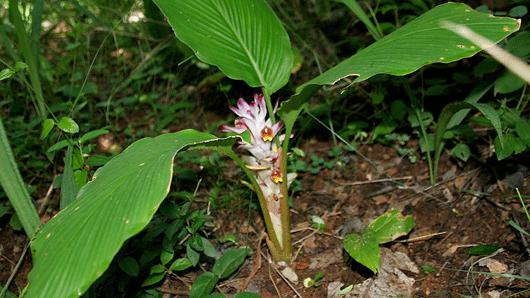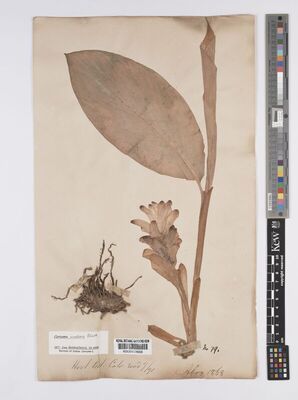-
General Description
-
Scentless turmeric is a perennial herb found only in India, where it is used in traditional medicine for the treatment of muscular pain, psychosomatic disorders and constipation.
A genus within the ginger family (Zingiberaceae), Curcuma contains nearly 100 species, including turmeric (Curcuma longa), the underground stems of which are the source of the bright yellow spice. The name Curcuma comes from the Arabic kurkum meaning turmeric.
-
Species Profile
-
Geography and distribution
Curcuma inodora is native to India. It is reported to occur in Maharashtra, extending up to northern Karnataka, and has been more recently reported from Andhra Pradesh and Gujarat. It is common in barren, laterite areas, plains and roadside cuttings, and also occurs in tropical moist deciduous forest.
Description
A perennial herb that can grow up to 120 cm tall. Flowers are large, showy, pink-purple with a dark yellow band at the centre.
The plant is dormant from November to April/May when it appears above-ground again, growing up from its rhizomes (underground stems). This dormancy has given rise to the common name hidden lily.
Threats and conservation
The main threats to Curcuma inodora come from habitat loss and overharvesting (for local medicinal use and the horticultural trade). Its habitats have suffered from conversion to agricultural land and human settlements and are now highly fragmented over large parts of its range. However, occurrence of C. inodora along roadsides suggests that the species is able to persist and regenerate in disturbed and secondary vegetation.
Ornamental gingers have rapidly increased in popularity in the western world in the past few years, promoting an increase in illegal collecting.
Conservation assessments carried out at Kew
Curcuma inodora is being monitored as part of the 'IUCN Sampled Red List Index for Plants' project, which aims to produce conservation assessments for a representative sample of the world's plant species. This information will then be used to monitor trends in extinction risk and help focus conservation efforts where they are needed most.
Uses
Curcuma inodora is used in traditional medicine for the treatment of muscular pain. Tubers are mixed with water to form a paste, which is applied locally. It is also used in the treatment of psychosomatic disorders and constipation.
An attractive plant with large, showy flowers, scentless turmeric is also cultivated as an ornamental.
This species at Kew
Pressed and dried specimens of Curcuma inodora are held in Kew's Herbarium, where they are available to researchers from around the world, by appointment. The details of herbarium specimens of some other Curcuma species can be seen online in Kew's Herbarium Catalogue.
-
Distribution
-
India
-
Ecology
-
Tropical moist deciduous forest.
-
Conservation
-
Least Concern (LC) according to IUCN Red List criteria.
-
Hazards
-
None known.


